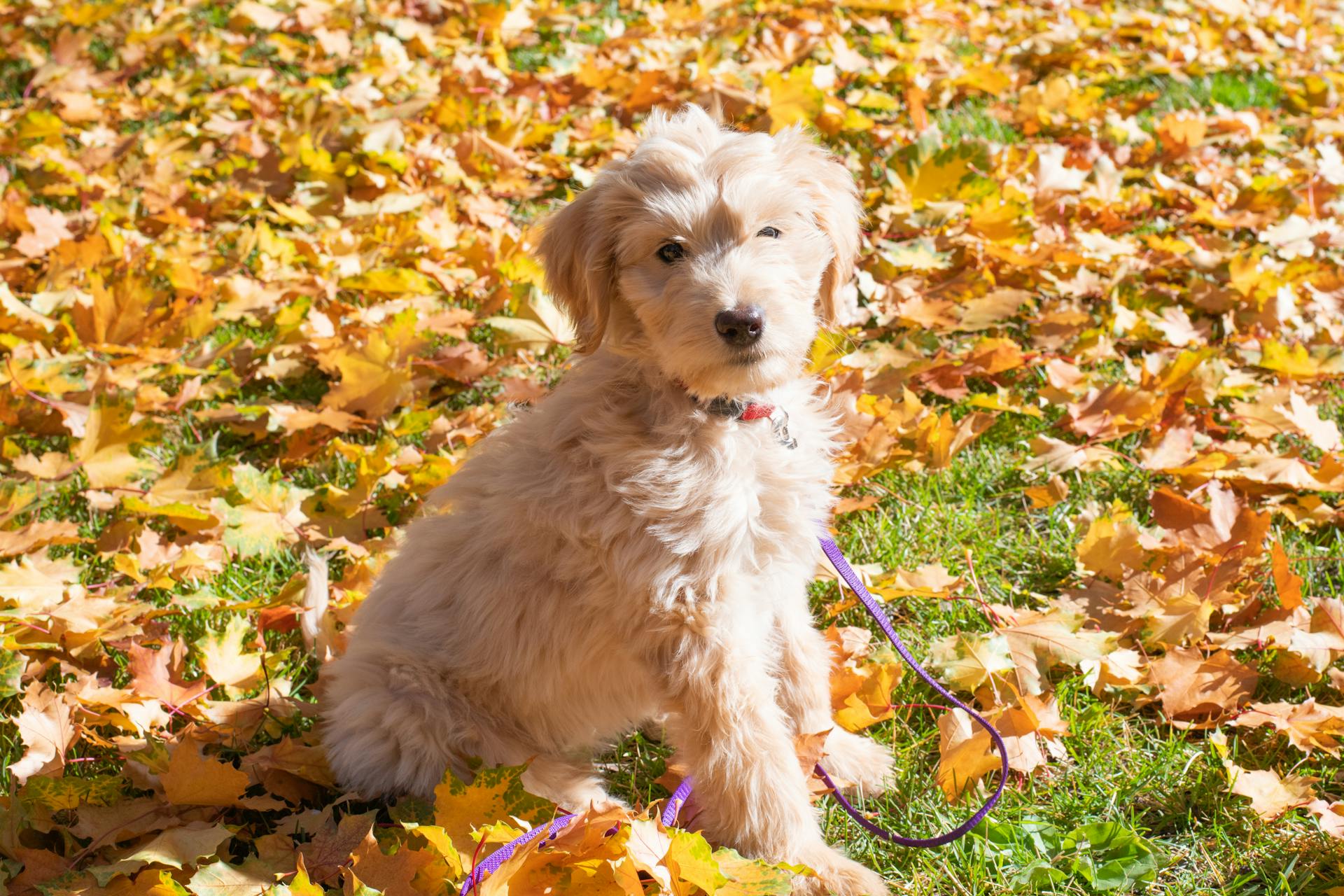
Goldendoodles are a popular breed known for their friendly and outgoing personalities, but did you know that they come in a wide range of colors?
From classic cream to rich chocolate, the colors of Goldendoodles can vary depending on the combination of Poodle and Golden Retriever genes. The most common colors include cream, gold, black, red, and apricot.
The genetics of Goldendoodles play a significant role in determining their coat color. Poodles can carry the gene for a black coat, while Golden Retrievers are more likely to have a golden coat. The interaction of these genes can result in a variety of colors, including the rare silver and blue colors.
Intriguing read: When Do Goldendoodles Lose Their Puppy Coat
Colors of Goldendoodles
Goldendoodles can inherit a wide range of coat colors from their parents. The exact color depends on the mix of dominant and recessive genes they receive.
Their coat color is determined by the interaction of genes from both parent dogs. This means that every Goldendoodle is unique in terms of their coat color.
The possible combinations of genes result in various coat colors, making each Goldendoodle special.
Additional reading: Do Goldendoodles Change Color
Apricot
Apricot Goldendoodles are a variation on red, giving pups a cute teddy bear appearance.
Their coat color starts off a little darker and lightens over time, sometimes being confused with cream or tan ones. This is because the interplay of genes can cause it to lighten considerably.
Apricot Goldies almost always have black eyes, eye rims, noses, and toenails, inherited from the Poodle parent.
This color is created by a recessive gene, meaning the puppy must inherit it from both parents.
Related reading: Apricot Goldendoodles
Champagne
Champagne Goldendoodles are extremely rare, but they're definitely out there. These dogs have a recessive red gene that's diluted into a stunning pale yellow tone.
Their coats are light and beautiful, with a yellowish tinge that's hard to miss. In some cases, it might be tricky to tell the difference between a cream Goldie and a champagne one.
Champagnes tend to have a touch more color than cream Goldies. They lean more towards the Retriever's golden than the cream's pale apricot or slight café au lait hue.
Puppies may be born with a darker golden coat that lightens as they age.
Black
Black Goldendoodles are relatively uncommon due to their lack of popularity among potential owners, who often prefer other colors that enhance the breed's signature teddy bear look.
The gene that creates a black coat is recessive, making it less likely to appear in first-generation dogs.
Black Goldendoodles are more likely to appear in second and third-generation dogs.
The Poodle fading gene can cause black Goldendoodles to silver down to grey, blue, or silver as they mature.
These pups can be quite striking, but their unique coloring can be fleeting.
Recommended read: Weimaraner Colors Silver
Blue
Blue Goldendoodles are a rare and beautiful sight, with a darker, more steely shade that's quite distinct from gray ones.
Their coat can have both darker and lighter patches, making each one unique.
This color is recessive, so it takes multiple generations of Goldendoodle breeding to achieve.
Like gray Doods, blues are born dark and fade out across the first two years of their lives.
Their coats may even continue to clear as they age, but a select few will remain truly blue.
You never really know what you are going to get when you adopt a black Goldie, which is part of their charm.
Consider reading: Blue Heeler Colors
Silver
Silver Goldendoodles are a lighter version of blue or gray Goldies, born a much darker color that fades over time. Their coat color change is one of the most dramatic, transforming them into a completely different dog.
You might start to notice lighter roots in your pup around six to ten weeks, along with white or silver hairs between their toes.
The shift from black to silver takes several years, making it easy to mistake them for grays early on in life.
Take a look at this: Chocolate Color Labrador
Silver Beige
Silver Beige Goldendoodles are born dark brown, but don't worry, they'll lighten up as they age.
Their coat color will start to change as early as six to twelve weeks, and they may end up with a beautiful café au lait shade or a light silver color.
Patterns and Variations
Parti Goldendoodles are defined by at least 50% white coloring, coupled with a different, secondary color in various patterns across their body. Parti 'Doodles are especially unique because no two are alike.
See what others are reading: Parti Goldendoodles
The Parti coat can also come in variations such as Tuxedo and Abstract, where the Tuxedo variation means there is white specifically on the neck, chest, and feet, and the Abstract variation means there is some white on the doodle, but the overall white amounts to less than 30% of their total coat.
Goldendoodles can also come in Brindle, a rare and striking pattern of dark and light coat that makes the dog look like it has tiger stripes, usually in the form of a black or brown base coat with lighter colored stripes.
Patterns
Parti coats are a common pattern in Goldendoodles, characterized by at least 50% white on their coat, often paired with another color. This pattern can result in a variety of markings and color combinations.
Tuxedo coats are a variation of the parti coat, with white specifically on the neck, chest, and feet. This creates a distinctive "tuxedo" appearance.

Abstract coats are another variation of the parti coat, with some white on the doodle, but not enough to meet the 50% requirement. This can result in a unique and interesting pattern.
Brindle coats are a rare but striking pattern, characterized by a dark and light coat arrangement that resembles tiger stripes. This pattern is the result of a recessive gene and can be difficult to predict.
Some Goldendoodles may have a mostly white coat, but this can be associated with sunburn and deafness. It's essential to work with a reputable breeder who can verify the pup's hearing.
Variations
Parti Goldendoodles are a visual feast, offering a delightful mix of colors. They come in beautiful two-toned combinations, such as Chocolate and White Parti, Caramel and White Parti, and Black and White Parti variants.
The Parti gene is a recessive one, and Goldendoodles need two of these genes to express it. This means Parti dogs are only found in second and third generations, as Golden Retrievers don't carry these genes. However, there are plenty of Parti Poodles about.
Merle Goldendoodles are another extremely uncommon type, with a unique "swirl pattern" coat. They have a lighter base coat overlaid with swirls of darker colors, and every Merle dog is completely unique.
Here's an interesting read: Merle Goldendoodles
Tri-Colored
Tri-colored Goldendoodles are relatively rare because this type of coloring doesn't occur in either Poodles or Golden Retrievers.
The tri-color gene is more common in breeds like Bernese Mountain Dogs, which is why you often find Goldendoodles with this coloring aren't strictly speaking Goldendoodles, but rather a mix with another breed.
Golden Mountain Doodles, a mix of Golden Retrievers, Bernese Mountain Dogs, and Poodles, are becoming increasingly popular, and their tri-coloring is a big part of their appeal.
Explore further: Are Goldendoodles Good Running Dogs
Predicting and Determinants
Predicting Goldendoodle colors can be tricky because the Poodle's varied shades are dominant, making it difficult to predict the exact color of the puppy. The Poodle colors are more likely to come through, especially in first-generation Goldendoodles.
Goldendoodles can come in pretty much every color that a Poodle comes in, and sometimes more besides. Unlike Poodles, pedigree standards do not govern the breeding of Doodles.
To determine the coat colors of Goldendoodles, we need to look at the gene pool passed on from the parents, which is made up of two basic pigments: Eumelanin (black) and Phaeomelanin (red).
Check this out: Miniature Poodle Colors
Predicting

Predicting the color of a Goldendoodle can be a challenge. Goldendoodles likely won't be golden due to the Poodle's varied shades being dominant over the Golden Retriever's limited colors.
It's impossible to predict with certainty what color a Goldendoodle will be. The interaction of genes that determine coat color makes it complicated, especially with later-generation dogs.
First-generation Goldendoodles will likely be a similar color to their Poodle parent. But things get even more complicated with later-generation dogs, where more Poodle genes come into play.
Even two black dogs can produce a golden puppy if both parents have recessive golden color alleles. This shows just how unpredictable Goldendoodle colors can be.
Breeders may opt to have their dogs tested to see which alleles they carry, making coat-color predictions more accurate. This can help breeders and owners make more informed decisions.
See what others are reading: Goldendoodles Michigan Breeders
Determinants of a Dog's Coat
Dogs have only two basic color "building blocks" or pigments: Eumelanin (black) and Phaeomelanin (red). These two pigments are responsible for creating the vast variety of colors found in Goldendoodles.
Expand your knowledge: Can You Breed Two Goldendoodles

The interaction of these two pigments determines the color of a dog's coat. Every color in a dog's coat is created by or derived from these two pigments.
To predict a Goldendoodle's coat color, you need to consider the gene pool passed on from its parents. The Poodle's varied shades are dominant, making it more likely for the puppy to inherit Poodle colors.
However, predicting a Goldendoodle's coat color is not an exact science. Even with two black parents, a puppy can inherit recessive golden color alleles and end up with a golden coat.
Consider reading: What Are Dog's Favorite Color?
Frequently Asked Questions
What is the rarest Goldendoodle color?
The rarest Goldendoodle color is blue, which is caused by recessive genes and takes multiple generations to achieve. This unique hue makes blue Goldendoodles highly sought after by doodle enthusiasts.
What color is the most expensive Goldendoodle?
The most expensive Goldendoodles typically have rare, multi-colored coats such as Phantom, Tri, Sable, Merle, and Parti. These unique colors can increase the purchase price by $500-$1000.
Which Goldendoodle has the curliest hair?
A Goldendoodle with a curly coat is typically +/+ for the curl gene, resulting in the tightest, most defined curls. This genotype is often associated with the most pronounced curl pattern.
Sources
- https://www.knudawnsoutherngoldendoodles.com/goldendoodle-colors
- https://doodledoods.com/goldendoodle-colors-coat-patterns/
- https://www.nydandydoodles.com/goldendoodle-colors/
- https://mountainmeadowpuppies.com/goldendoodle-coat-colors-everything-you-need-to-know/
- https://www.jennaleedoodles.com/post/doodle-colors-patterns-the-pinwheel-of-doodle-coats
Featured Images: pexels.com


